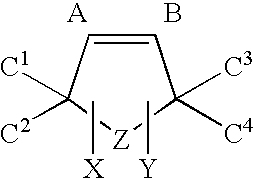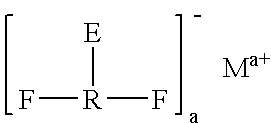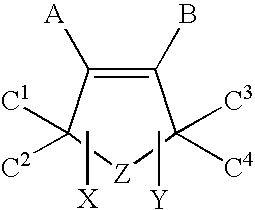Ionomeric oxygen scavenger compositions
a technology of oxygen scavenger and composition, which is applied in the direction of explosives, containers preventing decay, synthetic resin layered products, etc., can solve the problems of oxygen ingress, oxygen ingress, and importance of oxygen permeation through the body, and achieves low tack, easy formation and processing
- Summary
- Abstract
- Description
- Claims
- Application Information
AI Technical Summary
Benefits of technology
Problems solved by technology
Method used
Image
Examples
example 1
Cis-1,2,3,6-Tetrahydrophthalic Anhydride / 1,6-Hexanediol Condensation Polymer with 10% Dimethyl 5-sulfoisophthalate, Sodium Salt
THPA based polyesters were produced using a 2-step process. The first step involved condensation of the tetrahydrophthalic anhydride (THPA), 1,6-hexanediol, and dimethyl-5-sulfoisophthalate, sodium salt reactant with distillation of water and methanol from the mixture to give low molecular weight polyesters. The second step involved increasing the molecular weight of the polymers so produced via transesterification, by beating at higher temperatures under vacuum in the presence of an appropriate catalyst.
A 250 ml round bottom flask, equipped with a stirrer, heating mantle, thermocouple well, nitrogen inlet and a distillation head was charged with 75 g of 1,6-hexanediol, 18.6 g dimethyl 5-sulfoisophthalate, sodium salt, 0.15 g potassium carbonate, 0.07 g of trimethylolpropane, 500 ppm (0.09 g) IRGANOX™ 3114 and 0.045 g of titanium(IV) butoxide. The reaction m...
example 2
Cis-1,2,3,6-Tetrahydrophthalic Anhydride / 1,6-Hexanediol Condensation Polymer with 2.5% Dimethyl 5-sulfoisophthalate, Sodium Salt
A 250 ml round bottom flask, equipped with a stirrer, heating mantle, thermocouple well, nitrogen inlet and a distillation head was charged with 69.39 g of 1,6-hexanediol, 86.25 g of 1,2,3,6-tetrahydrophthalic anhydride, 4.65 g dimethyl 5-sulfoisophthalate, sodium salt, 0.15 g potassium carbonate, 0.067 g of trimethylolpropane, 500 ppm IRGANOX™ 3114 and 0.05 g of titanium(IV) butoxide. This is a 1.008 mole ratio of diol to anhydride / ester. The reaction mixture was heated with distillation at 175° C. for one hour, then the temperature was increased to 190° C. and then to 220° C. and heated for one hour. During this time 13.7 g of distillate was collected.
In the second step, 0.05 g of additional titanium butoxide was added to the mixture, and the reaction mixture was heated under vacuum starting at 140° C. slowly increasing to 250° C. (0.2-0.6 mm) and held fo...
examples 3-6
Additional polymers containing dimethyl 5-sulfoisophthalate, sodium salt at 5% to 15% by weight were prepared according to the procedure described in Examples 1 and 2. See Tables 1 and 2 for details.
PUM
| Property | Measurement | Unit |
|---|---|---|
| thickness | aaaaa | aaaaa |
| thickness | aaaaa | aaaaa |
| temperatures | aaaaa | aaaaa |
Abstract
Description
Claims
Application Information
 Login to View More
Login to View More - R&D
- Intellectual Property
- Life Sciences
- Materials
- Tech Scout
- Unparalleled Data Quality
- Higher Quality Content
- 60% Fewer Hallucinations
Browse by: Latest US Patents, China's latest patents, Technical Efficacy Thesaurus, Application Domain, Technology Topic, Popular Technical Reports.
© 2025 PatSnap. All rights reserved.Legal|Privacy policy|Modern Slavery Act Transparency Statement|Sitemap|About US| Contact US: help@patsnap.com



